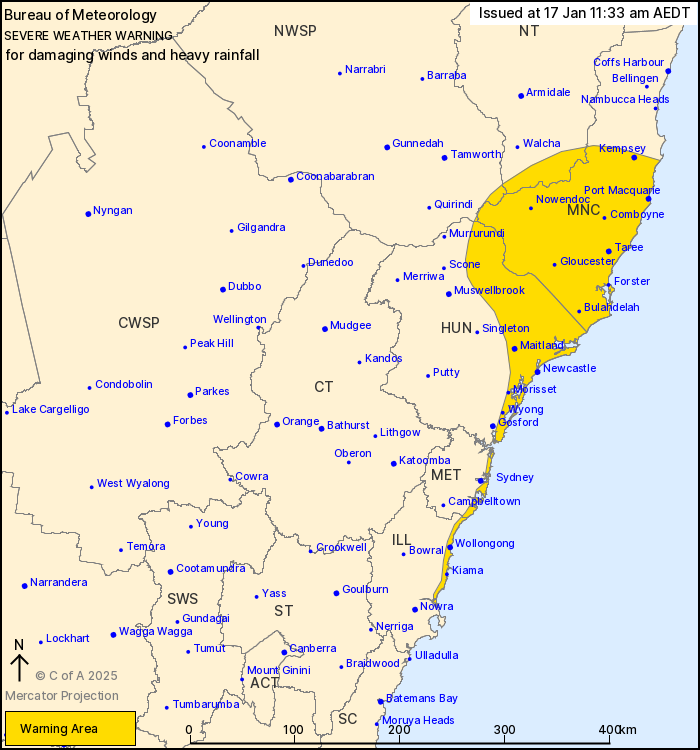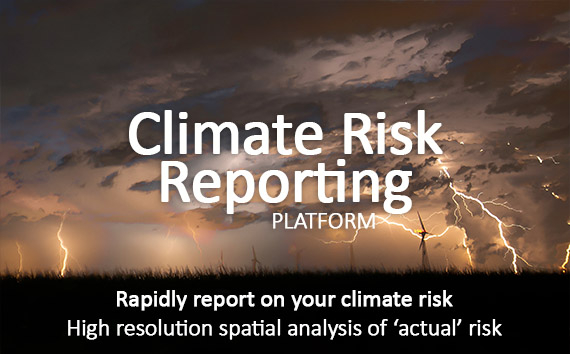Source: Bureau of Meteorology
For people in Mid North Coast and parts of Hunter, Metropolitan,
Illawarra, Northern Tablelands and North West Slopes and Plains
Forecast Districts.
Issued at 11:33 am Friday, 17 January 2025.
Heavy rainfall and damaging winds developing today.
Weather Situation: A low pressure system has developed off of the
northern NSW coast, resulting in rainfall about the Hunter and Mid
North Coast as well as southerly winds along the coastal fringe
from Sydney to Seal Rocks.
Locally strong to DAMAGING WINDS averaging 55 to 65 km/h with peak
gusts of around 90 km/h are possible on exposed parts of the coast
from Nowra to Seal Rocks, particularly for parts of the coastline
facing towards the south. Winds are expected to increase during
Friday morning, peaking in the afternoon and easing below warning
thresholds by early Saturday morning.
HEAVY RAINFALL which may lead to FLASH FLOODING is forecast for
the northern Hunter and Mid North Coast districts today, with the
rain rates expected to begin to increase early this afternoon and
continue through to tomorrow. Six-hourly rainfall totals between 70
and 120 mm remain possible through to Saturday evening,
particularly on elevated terrain.
A separate Coastal Hazard Warning for Damaging Surf is current
between the Illawarra and the Mid North Coast. Flood watches and
warnings are also current. For all the latest warnings, please
refer to http://www.bom.gov.au/nsw/warnings/ for details.
Locations which may be affected include the coastal fringe of
Sydney, The Entrance, Port Macquarie, Taree, Bulahdelah, Newcastle
and Maitland.
91 km/h wind gust recorded at Sydney Airport at 9:51 am.
91 km/h wind gust recorded at Kurnell at 10:01 am.
104 km/h wind gust recorded at Molineux Point at 10:32 am.
98 km/h wind gust recorded at Bellambi at 11:02 am.
The State Emergency Service advises that people should:
* Don't drive, ride or walk through flood water.
* Keep clear of creeks and storm drains.
* If you are trapped by flash flooding, seek refuge in the highest
available place and ring 000 if you need rescue.
* Be aware that run-off from rainfall in fire affected areas may
behave differently and be more rapid. It may also contain debris
such as ash, soil, trees and rocks.
* After bushfires, heavy rain and the loss of foliage can make the
ground soft and heavy, leading to a greater chance of
landslides.
* Move vehicles under cover or away from trees.
* Secure or put away loose items around your house, yard and
balcony.
* Keep at least 8 metres away from fallen power lines or objects
that may be energised, such as fences.
* Trees that have been damaged by fire are likely to be more
unstable and more likely to fall.
* Report fallen power lines to either Ausgrid (131 388), Endeavour
Energy (131 003), Essential Energy (132 080) or Evoenergy (131 093)
as shown on your power bill.
* Stay vigilant and monitor conditions. Note that the landscape
may have changed following bushfires.
* For emergency help in floods and storms, ring your local SES
Unit on 132 500.

17/Jan/2025 01:11 AM



